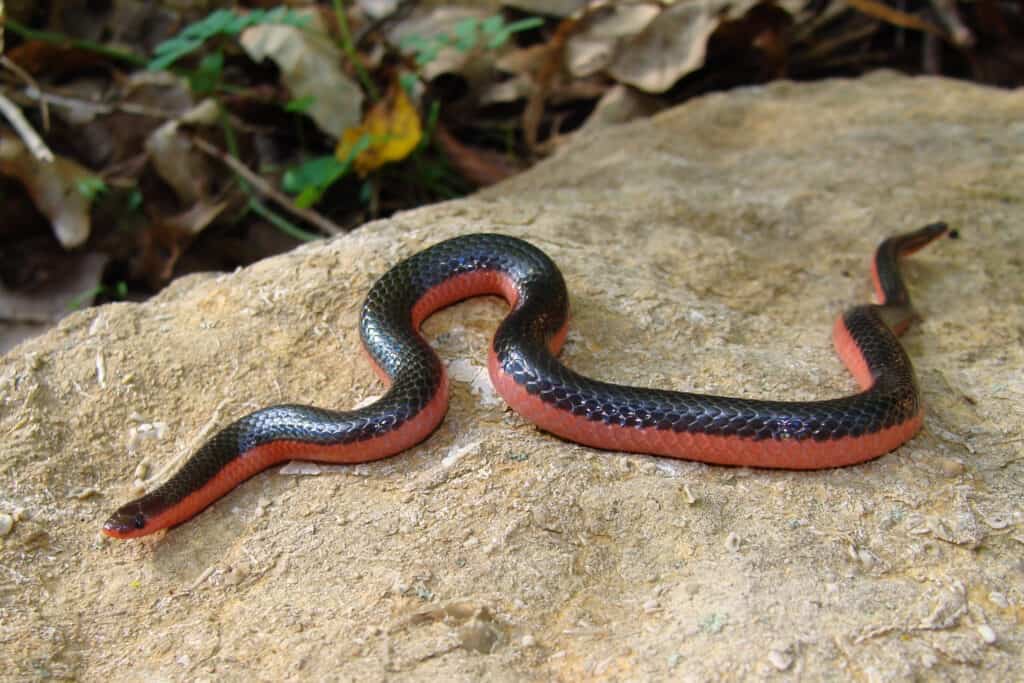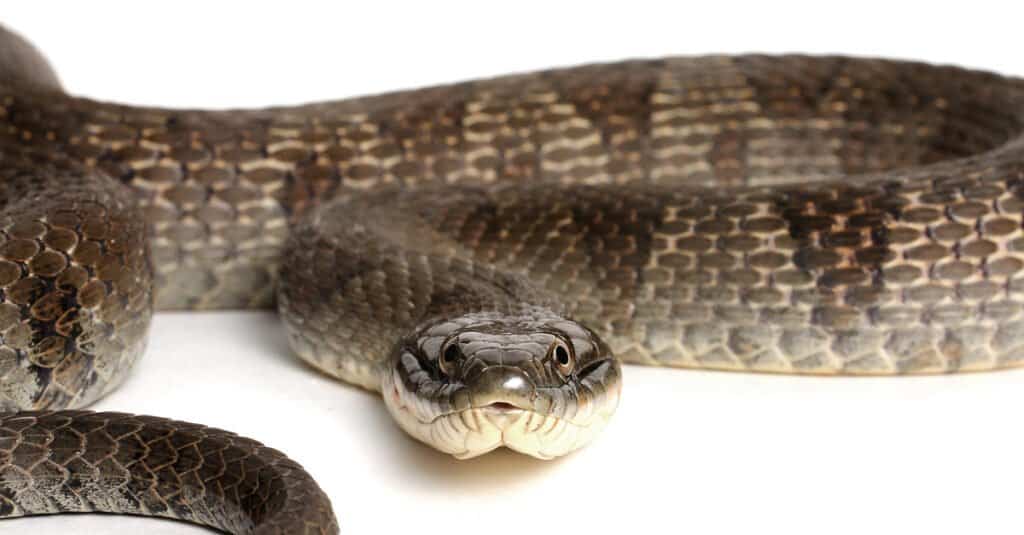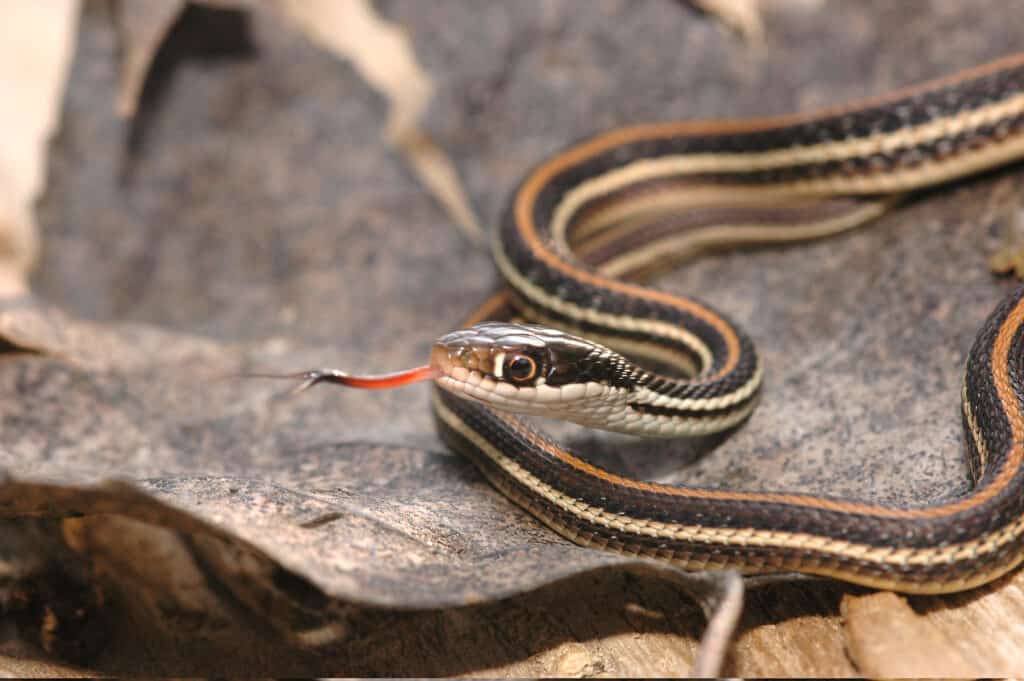Kansas is home to 42 species of snakes – six of which have black colorings. Although many people fear these reptiles, it is important to understand that, just like you, these snakes are an important part of the food chain. Without snakes, several species of animals which they prey upon will increase in number and destroy the balance of the ecosystem. This is why it is important to avoid killing snakes unless in life- or injury-threatening situations.
If you live in Kansas and have a fear of black snakes, one way to overcome this problem is by identifying and understanding them. This way, you can feel less panic and contact the appropriate authorities if you sight a black snake. Here’s an overview of how they look:

Read further for more information about these snakes.
Black Rat Snake

©Psychotic Nature/Shutterstock.com
Western rat snakes, also known as black rat snakes, are very commonly seen in Kansas. As adults, they weigh up to 3 pounds and grow to up to 75 inches. These snakes are commonly called black snakes because of their colors. Their entire bodies are black with irregular patterns from their head to their tails while their bellies are either yellowish-white or cream with dark markings
These snakes are neither venomous nor aggressive despite their dark looks. They are very adaptable in terms of habitat and make excellent pets. They feed mainly on birds, bird eggs, rodents, and rabbits. They do this by constricting the prey to immobility and killing them.
Black Snake Rats are most often preyed upon by hawks. They are scoped from the bird’s eye view and swooped down upon. To protect themselves, they use a trick popular with all rat snakes; they vibrate their tails so they look like venomous rattlesnakes.
Western Worm Snake

©Matt Jeppson/Shutterstock.com
The western worm snake is a colubrid species found around America. They have dark or black coloration that runs from their heads to their tails. However, these snakes are not only black. Their bellies are usually colored red or pink.
Not only are these snakes beautiful to watch, but they are also non-venomous and shouldn’t scare you. Western worm snakes, as their name implies, aren’t long or large snakes. They measure from 7.5 inches to 14.8 inches in length and aren’t very heavy.
They even make great pets, provided you know how to keep them. However, it is important to know that feeding these animals in captivity can be tasking. At times, it can be hard to tell if they are eating, and sometimes, they starve themselves to death!
Northern Watersnakes

.
©Michiel de Wit/Shutterstock.com
Northern Watersnakes, which shouldn’t be confused with cottonmouths, are easy to spot in Kansas. They come in various colors such as black, brown, gray, or even red. However, black watersnakes are very rare.
Generally, watersnakes measure from 2 to 4.5 feet and weigh anywhere between 5.6 ounces and 14.4 ounces. Female watersnakes are larger than their male counterparts, however. They are nonvenomous animals and cannot kill humans. This does not stop them from biting and defending themselves from predators or unwanted contact with humans by spraying excrement and musk all over them. However, the musk and excrement sprayed are only defensive.
Watersnakes’ salivas also contain a mild anticoagulant. This means that it will prevent the clotting of blood and make the wound bleed more.
Western Ribbon Snake

.
©iStock.com/Shoemcfly
The Western Ribbon Snake is a species of garter snake. It is nonvenomous and measures between 16 to 35 inches. They are usually colored black, olive, or brown and have light-colored stripes. These snakes are usually found in wet areas such as streams and lakes.
Western Ribbon snakes are not aggressive and hardly bite even when they are attacked. Due to their sizes and colors, they find it easy to camouflage into their surroundings. If you come across a western ribbon snake in the wild, you can leave it well on its own, without any fear. They make great pets and are an awesome choice for new snake owners.
Plainbelly Watersnake

©Tyler Albertson/Shutterstock.com
Plainbelly watersnakes are also called plain-bellied watersnakes and are found in the lakes and rivers of Kansas City. They can be black, brown, gray, or olive green. They have no markings on their side and are more active in warmer weather.
They are nonvenomous snakes and do not attack humans unless threatened. When attacked by predators, their first move is to attempt to escape over land or water. If this fails, they can and will bite their predators. Although non-venomous, they release musk with foul odors just like northern watersnakes. They are, however, shorter than northern water snakes and measure anywhere from 24 to 40 inches as adults.
Northern Cottonmouth

Often found in the Cherokee County in Kansas, Northern cottonmouths have black or brown scales. A northern cottonmouth will have a uniform color and no rattle in its tail. They also have weird noses since they have heat-sensing pits that look a lot like nostrils. However, their pits aren’t as predominant and visible as the copperhead’s which is often mistaken for another pair of nostrils
They are more active at night and use their heat-sensing pits to find prey. These snakes have a reputation for being aggressive and highly venomous. While it is true that northern cottonmouths are indeed extremely venomous and can kill humans, they are actually not aggressive and most often strike only in defense. However, they stand their ground when confronted or approached by humans. Northern cottonmouths usually measure around 30 to 40 inches long. They are often kept as pets but this is rather dangerous and should only be done by trained experts.
What to Do if You Come Across a Black Snake in Kansas
If you come across a black snake in Kansas, leave it alone or call the appropriate authorities- depending on where it is spotted. It is not a good idea to capture a wild snake and try to keep it as a pet. A wild snake will hate being kept captive and will attempt to attack irrespective of its demeanor. Sometimes, they even starve themselves to death. Be sure to get your pets from a pet store.
The photo featured at the top of this post is © Linda Burek/Shutterstock.com
Discover the "Monster" Snake 5X Bigger than an Anaconda
Every day A-Z Animals sends out some of the most incredible facts in the world from our free newsletter. Want to discover the 10 most beautiful snakes in the world, a "snake island" where you're never more than 3 feet from danger, or a "monster" snake 5X larger than an anaconda? Then sign up right now and you'll start receiving our daily newsletter absolutely free.
Thank you for reading! Have some feedback for us? Contact the AZ Animals editorial team.






